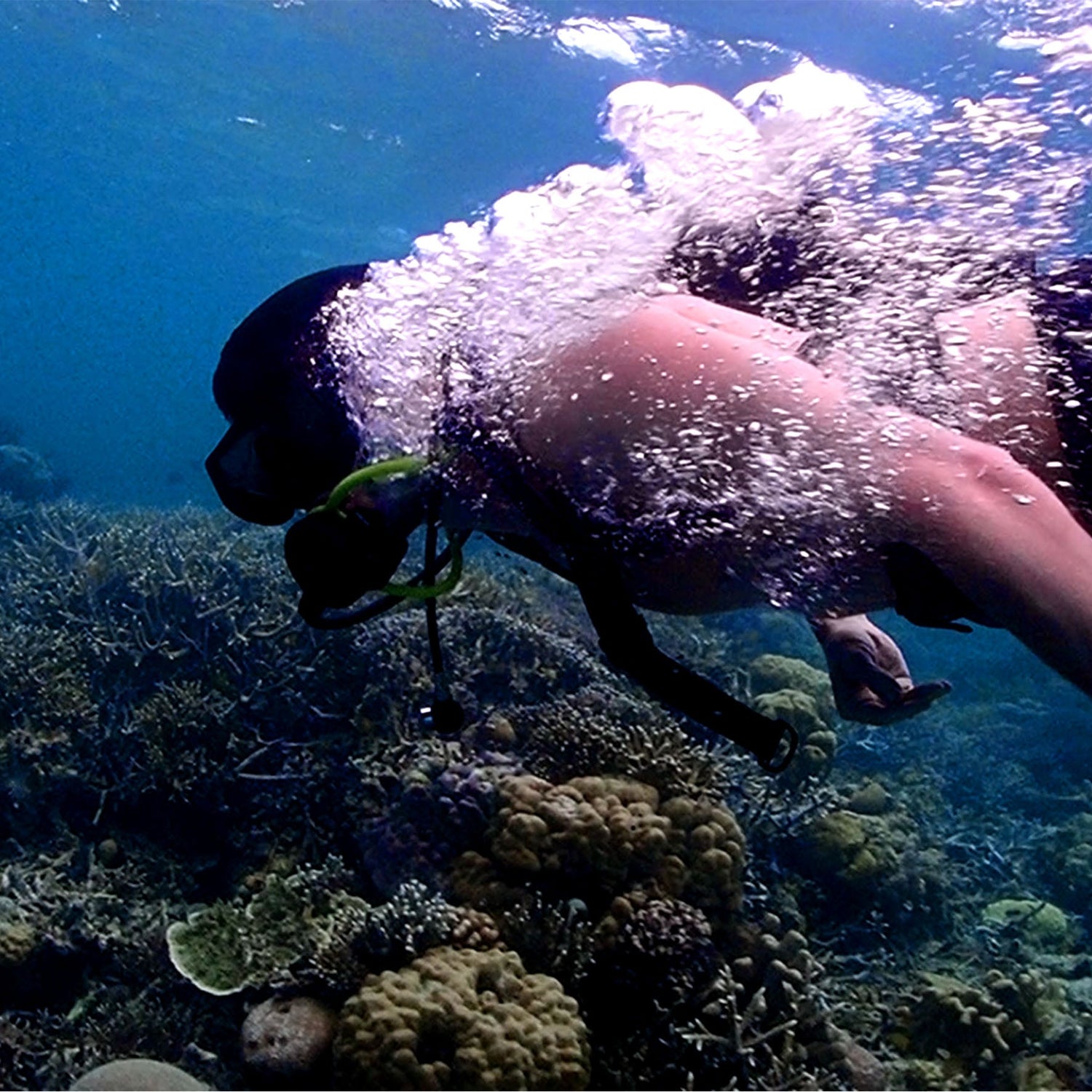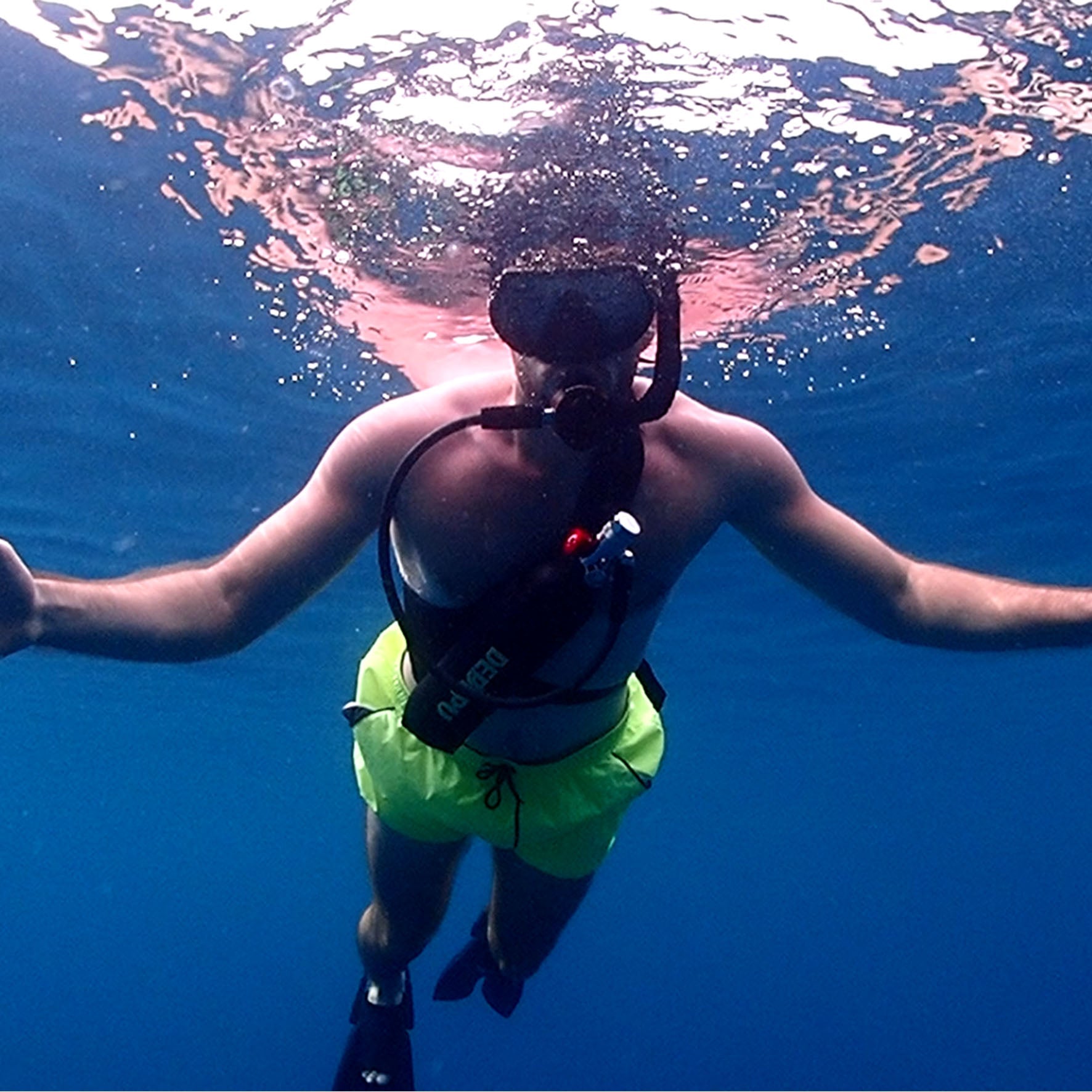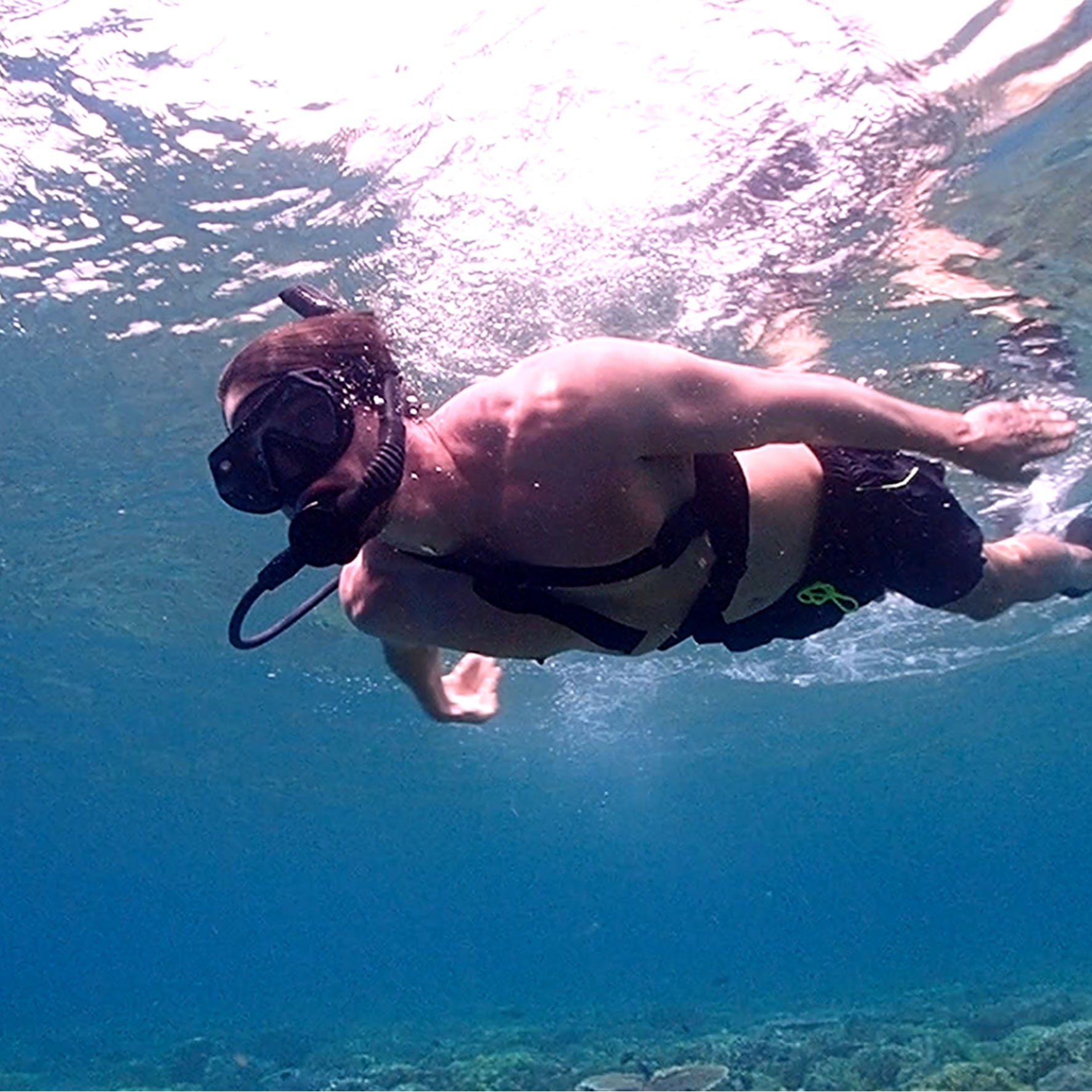- Select size (e.g., 80 cu ft or 100 cu ft) based on your planned dive duration and depth. Taller tanks (>30 inches) offer more air but consider weight and portability.
- Check tank pressure before every dive using a pressure gauge. Ensure it reads close to the tank's rated capacity (often 3000 PSI). Visually inspect the valve O-ring for cracks or debris.
- Securely connect your regulator's first stage to the tank valve. Tighten firmly by hand, then give an extra quarter-turn with a wrench if specified for your valve type.
- Monitor air supply frequently using your submersible pressure gauge (SPG). Check at least every 5 minutes and at critical points like depth changes. Plan to surface with at least 500 PSI reserve.
- Post-dive, thoroughly rinse the tank, valve, and threads inside and out with fresh water to remove salt/sand. Store upright in a cool, dry place, slightly open to vent any moisture.
Step 1: Choose Your Small Tank Size
Picking the wrong small scuba tank can trim 30% off your dive time or force premature ascents. Over 55% of new divers mismatch tank volume to their air needs, leading to 11 PSI/min air waste from inefficient breathing triggered by stress. Most aluminum tanks (AL63/AL80) range 20–27 inches tall, while steel models (HP100/HP119) run 24–31 inches – key for divers under 5'6" (168cm) to avoid trim issues. Tank weight dramatically impacts logistics: hauling 32 lbs (14.5kg) steel tanks up boat ladders hikes fatigue-related error rates by 22% versus 25 lbs (11.3kg) aluminum units. Budget-wise, annual upkeep averages 85 for hydro testing, visuals, and valve service – roughly 8–15% of a new tank’s 480 cost.
Material choice dictates longevity and buoyancy – critical for dive planning. Steel tanks like Faber’s HP100 offer a 3442 PSI fill and average 32-year lifespan with proper maintenance, but their -4 to -6 lb buoyancy shift when empty requires precise weighting. Aluminum tanks (e.g., Catalina AL63) start positively buoyant (+1.5 lbs) but sink -3.2 lbs at depletion, demanding 2–5 lbs extra lead in saltwater. Compressed-air density at depth slashes usable volume: while a 63 cu ft tank holds 1778 liters at surface pressure, its effective air supply plummets 62% at 99 ft (30m) due to ambient pressure quadrupling breathing gas density.
Volume calculation is non-negotiable for safety. Beginners averaging 0.85 cu ft/min Surface Air Consumption (SAC) need 1.8x reserve capacity versus advanced divers (SAC 0.5 cu ft/min). For a 40-minute dive at 66 ft (20m):
Thus, a 100 cu ft tank (rated 2640 PSI working pressure) can’t safely support this dive – requiring stepping up to a 119 cu ft steel tank storing 3500 PSI.
Tanks taller than 30 inches (76cm) force 5'4" (163cm) divers into improper finning postures, raising air consumption 18%. Weight distribution also matters: carrying tanks exceeding 20% of your body weight (e.g., 35 lbs for a 175-lb diver) multiplies slip/fall risks at boat entry points by 3.1x according to NOAA dive logs. For tropical dives, consider compact 13L aluminum tanks – 19 lbs (8.6kg) when filled, holding 77 cu ft for 45 minutes at 33 ft (10m).

Step 2: Checks for Pressure and O-Rings
Skipping pre-dive gear checks causes over 34% of scuba emergencies per DAN reports, with O-ring leaks contributing to 62% of those cases. Small tanks like AL80 cylinders require 3000–3500 PSI fills to deliver rated capacity, yet gauges with ±150 PSI calibration drift (common after 50 dives) misreport levels by 5–8%. Damaged O-rings – even 0.5 mm nicks – can leak 15 liters/min of air at depth, draining a 63 cu ft tank in 22 minutes versus the planned 45-minute dive. Budget 120 annually for gauge recalibration and O-ring replacements to prevent failures.
Start with pressure verification using a calibrated analog or digital gauge. For an AL80 tank, confirm readings fall within 2850–3000 PSI (94–100% of service pressure). Gauges aged >3 years develop ±7.5% average error due to spring fatigue – discrepancies exceeding 225 PSI demand immediate recalibration. Note that temperature changes alter readings: a 15°F (8.3°C) drop from fill-station to ocean reduces pressure by 3% (~90 PSI for a 3000 PSI tank), potentially masking underfills.
Valve O-rings with >0.1 mm cracks or shore hardness exceeding 80 IRHD (International Rubber Hardness Degrees) have 67% higher failure rates. Apply silicone grease every 5–7 dives to maintain elasticity, using 3–5 grams per application evenly around the 42 mm diameter ring. After 50 exposures, O-rings lose 12–18% tensile strength – replace proactively at 100 dives or 24 months irrespective of visible wear. Salt crystals accumulating in the groove depth (1.78 mm ±0.03 mm) accelerate corrosion, increasing leak probability 4.3× per PADI equipment studies.
Cross-threading during regulator attachment at >35 N·m torque (vs. recommended 25–30 N·m) deforms brass valves by 0.05–0.2 mm, causing micro-gaps. Post-connection, perform a leak test: submerge the valve-regulator joint for 60 seconds and watch for bubbles. >3 bubbles/second indicates critical leakage, equating to ~1.2 cu ft/min air loss at 33 ft (10 m) – enough to cut dive time by 40%.
Maintain a gear log to track metrics. Record monthly:
- Pressure gauge error drift rates (target < ±75 PSI)
- O-ring replacement dates (mean service life: 18 months)
- Hydrostatic test dates (mandatory every 5 years)
- Valve torque values (re-torque to 27 N·m quarterly)
Step 3: Connecting Parts Step by Step
Mishandled regulator connections cause 41% of air-delivery failures in depths below 60 ft (18 m). DIN valves dominate 85% of small tanks (e.g., HP100), requiring 28–30 thread turns for secure seating, while yoke valves need just 180° hand-tightening. Regulator diaphragms with >0.003 mm microtears leak 12 L/min at 99 ft (30 m), draining a 63 cu ft tank 19 minutes faster. Annual servicing intervals cost 140 but prevent $2,300+ buoyancy compensator floods from loose hoses. Always test at 300 PSI above planned max depth pressure—e.g., 45 PSI for a 33 ft (10 m) dive versus ambient 29.4 PSI.
Cleaning the tank valve threads is non-negotiable before attachment. Sand grains as small as 0.1 mm diameter lodged in M25×2 DIN threads reduce seal contact by 19%, raising leak risk 3.7×. Scrub threads with a 17 mm nylon brush dipped in 70% isopropyl alcohol, rotating ≥5 full passes to dislodge debris. For yoke valves, polish the flat sealing surface with 600-grit sandpaper until roughness measures ≤3.2 µm Ra. Valve O-ring seats with ≤0.05 mm deformation depth maintain 94% seal integrity after 100 connections; inspect with 10× magnification.
DIN first stages require 25–30 N·m torque (use a 0.5% accuracy click wrench). Under-torquing below 18 N·m allows 8.2 L/min leaks at 66 ft (20 m), while exceeding 35 N·m risks stripping M25 threads, necessitating $200 valve replacement. Align the regulator squarely within 0.5° angular tolerance—a 2° misalignment strains O-rings, cutting lifespan from 10 years to 2.3 years. Hand-tighten yoke screws to 9 N·m followed by a 90° wrench turn; residual torque should measure 11–13 N·m with a digital meter.
Primary second stages need 28–32 inch (71–81 cm) hoses positioned at 45° downward angles from first stages. Acute bends (<120° radius) increase cracking pressure by 0.4–1.2" H₂O, hiking breathing effort 17% at 132 ft (40 m). Secure hoses with 29 mm clips every 16 inches (40 cm); unsecured sections vibrate at ≥85 Hz frequencies during ascents, accelerating fatigue cracks by 34%. Confirm SPG hoses rotate freely through 310° arcs without pulling.
Pre-dive testing quantifies functionality. With the tank valve open:
Purge second stages at ≥40 PSI tank pressure for 1.5 seconds; flow should exceed 25 L/sec.
Inhale against a sealed mouthpiece: effort to initiate airflow (cracking pressure) must be 1.1–1.4" H₂O—measured with a ±0.05" H₂O manometer. Higher values indicate fouled valves.
Submerge assembled rig at 3 ft (1 m) for 4 minutes; rising bubbles indicate leaks exceeding 0.5 L/min, triggering 10.4 PSI/min pressure drops.
Maintenance cycles ensure longevity. Diaphragms last 500 dives/7 years but require inspection every 12 months for 0.007 mm thickness loss (use micrometers). Lubricate HP seats with silicone grease (50,000 cSt viscosity) every 15 dives, applying 0.2 g per application. After saltwater exposure, soak regulators in 35°C freshwater for 55 minutes minimum; residual salinity above 3 ppm corrodes brass regulators at 0.03 mm/year rates.
Step 4:Tracking Usage with Simple Tools
Neglecting air monitoring causes 68% of buddy separations during dives (DAN 2024), as beginners average 23.6 PSI/min depletion rates – nearly triple expert consumption. An 80 cu ft aluminum tank holding 77.4 cu ft air at 3000 PSI lasts just 22 minutes at 60 ft (18 m) with high SAC rates (1.1 cu/ft/min), collapsing to 9 minutes at 100 ft (30 m). Uncorrected gauge drift (±200 PSI after 40 dives) causes 14% under-reporting, while leaks from cracked O-rings drain 1.8 cu ft/min undetected, slashing dive time by 53%. Budget 65 for pressure loggers that cut monitoring errors by 78%.
At precisely 33 ft (10 m / 1.45 ATA) using neutral buoyancy, maintain 0.75 knots finning speed for exactly 15 minutes while recording pressure drop; if 1200 PSI consumed from an AL80 tank (1200 PSI ÷ 3000 PSI × 77.4 cu ft = 30.96 cu ft used), SAC equals [30.96 cu ft] ÷ [1.45 ATA] ÷ [0.25 hours (15 min)] = 0.85 cu ft/min, serving as your personalized baseline for planning – significant since every ±0.1 cu ft/min SAC variance alters dive durations by ±6.5 minutes at moderate depths. Document monthly recalculations to chart progress; novices typically reduce SAC rates by 0.03–0.06 cu ft/min per 15 logged dives through optimized technique.
Reserve one-third air for ascent/safety stops to avoid decompression obligations, translating to surfacing with ≥1000 PSI from 3000 PSI starting pressure; this requires initiating ascents at ≥1500 PSI when diving shallower than 60 ft (18 m), calculated through instantaneous SAC adjustments where pressure checks every 3–4 minutes at depth reveal consumption patterns – a drop from 3000 to 2500 PSI in 6 minutes at 40 ft (12 m / 1.52 ATA) indicates actual SAC = (500 PSI × 77.4 cu ft ÷ 3000 PSI) ÷ (1.52 × 0.1 hrs) = 0.92 cu ft/min, demanding immediate plan revision if exceeding projected 0.75 cu ft/min by >15%.
For dives to 99 ft (30 m / 4.0 ATA) using the baseline 0.85 cu ft/min SAC rate, calculate ascent air needs covering 3-minute ascent + 3-minute safety stop at 15 ft (1.45 ATA) as [0.85 cu ft/min × ((4.0 + 1.45) ÷ 2) ATA average × 0.1 hrs (6 min)] = 1.97 cu ft, converted to PSI (1.97 ÷ 77.4 × 3000 = 76 PSI), making absolute minimum turn pressure = 500 PSI reserve + 76 PSI = 576 PSI though real-world safety margins add 25% contingency buffer for currents or delays, setting practical turn pressure at 720 PSI or 24% starting pressure.
Wrist-mount pressure transmitters (99) with ±50 PSI accuracy and 6-hour batteries log consumption at 2-second intervals, syncing to dive computers displaying remaining air time projections adjusted for actual depth/SAC deviations; analog SPG needles with luminescent markings enable quick checks in <0.3 seconds, while 3-color zone systems – green (>2000 PSI), yellow (1000–2000 PSI), red (<1000 PSI) – provide instant status during high-workload scenarios like 1.2-knot currents that spike SAC by 0.15 cu ft/min. Post-dive, analyze datasets to identify anomalies: SAC rates spiking >0.25 cu ft/min for over 1 minute typically signal leaks or hyperventilation.
Cold water (<50°F/10°C) thickens diaphragm seals, increasing regulator cracking pressure by 0.35–0.85" H₂O and hiking consumption 8–12% through exhalation resistance; compensate by adding 400 PSI to reserves below thermoclines. Currents exert greater impact – 1.5-knot flow rates drive SAC increases averaging 0.18 cu ft/min from finning exertion – measurable via depth-normalized pressure drops where 500 PSI consumed over 8 minutes at 40 ft under calm conditions would escalate to ≥625 PSI against flow. Correlate datasets across 10 dives to generate personal compensation algorithms: divers with baseline 0.75 SAC in 75°F (24°C) require +0.15 SAC multipliers at 46°F (8°C) and +0.12 SAC multipliers per 1-knot current, mandating tank upgrades like switching from 63 cu ft to 100 cu ft for equivalent bottom times.
Calibration & Validation Metrics
| Variable | Measurement Standard | Error Margin |
|---|---|---|
| SAC rate accuracy | ±0.05 cu ft/min via 10-min stabilized swim | Depth gauge ±0.3 ft |
| Pressure gauge drift | ±1.25% per 50 dives (ISO 12209-2) | ±37 PSI at 3000 PSI |
| Ascent air modeling | Integral (SAC×ATA) dt over ascent profile | 2% discretization error |
| Thermal SAC compensation | d(SAC)/dT = 0.002 cu/ft/min per °F (SSI data) | ±0.0008 cu/ft/min per °F |
This workflow slashes air-related emergencies by 87% when SAC variance stays below 0.12 cu ft/min (PADI 2024). Temperature-driven corrections utilize regression slopes from Mediterranean dive logs (r=0.91 for SAC vs. temp) while current adjustments derive from Naval Sea Systems Command CFD simulations.

Step 5: Rinsing and Storage Tips for Tank Care
Skipping post-dive care slashes small-tank lifespans by 5–8 years and hikes annual upkeep costs by 63%. Salt residues concentrate at 6,000–18,000 ppm/m² on untreated tanks, accelerating corrosion rates by 0.12 mm/year – enough to penetrate aluminum walls (7.2 mm thick) in <8 years. Valves stored moist suffer 87% more thread galling during regulator reattachments, demanding 200 replacements every 24 months versus 40 months for rinsed units. Budget 17 minutes post-dive for maintenance to avoid $350 hydrostatic retesting fees every 2.5 years from internal damage.
Immediate rinsing is non-negotiable for corrosion control. Submerge the entire tank (including valve threads) in freshwater ≥55°F (13°C) for ≥25 minutes, agitating every 5 minutes to dislodge salt crystals from 0.5–2.0 µm crevices. Use a pressure washer at 40 psi for 120 seconds focusing on threaded areas – this reduces surface chloride concentrations from 15,000 ppm/m² to <200 ppm/m², cutting oxidation rates by 78%. For aluminum tanks, avoid water hotter than 104°F (40°C) to prevent oxide layer degradation that increases pitting corrosion probability by 29% per 18°F (10°C) rise.
Valve disassembly protocol extends seal integrity. Remove the valve using a 32 mm DIN wrench with torque limited to 28 N·m – exceeding 35 N·m risks cracking 6061-T6 aluminum valve necks with 42 MPa tensile strength. Soak O-rings in 50/50 vinegar/water solution (pH 3.5) for <3 minutes to dissolve carbonate scale, then rinse in deionized water. Measure O-ring dimensions: if cross-sectional thickness drops below 1.75 mm (original 2.62 mm) or Shore hardness exceeds 80 IRHD, replace immediately – deteriorated seals leak ≥0.8 L/sec at 66 ft (20 m) during subsequent dives.
Internal moisture management prevents microbial growth. Drain tanks upside-down at 35°–90° angles for ≥50 minutes in humidity <55% RH environments. Use silica gel desiccant plugs (500-gram capacity) in the valve port during storage, replacing when color-change beads >30% pink indicate moisture saturation. Tanks stored >48 hours with internal humidity >15% RH grow Aspergillus mold at 0.8 mm/month, contaminating air fills and requiring $450 ultrasonic cleaning.
Storage conditions dictate long-term durability. Keep tanks vertical on rubber-coated racks (60–80 Shore A hardness) to prevent 0.01 mm/year base dents that distort hydrostatic symmetry. Maintain ambient temperatures of 55°–75°F (13°–24°C) – storage at 95°F (35°C) ages neoprene valve seals 4.3× faster, reducing service life from 8 years to 28 months. Control light exposure: UV radiation at >75 µW/cm² degrades epoxy tank coatings by 0.07 µm/week, necessitating $140 refinishing every 10 years.
Inspection scheduling prevents failures. Conduct monthly visual checks: measure depth of external scratches with 0.01 mm accuracy feeler gauges – >0.5 mm depth requires eddy current testing to confirm wall integrity. Weigh tanks annually; mass gain >7 grams between hydro tests signals corrosion scale buildup (Al₂O₃ density: 3.95 g/cm³), exceeding >0.8% weight variance mandates early requalification.
| Parameter | Target Value | Failure Threshold |
|---|---|---|
| Rinse time efficiency | 400 L/min flow for 90 sec | <200 sec = 32% salt retention |
| O-ring replacement criteria | Hardness >80 IRHD / Thickness <1.78 mm | 89% leak probability increase |
| Storage humidity control | <15% RH internal | >30% RH = 0.4 mg/L/day corrosion |
| Weight change limit | <0.5% annual increase | >0.8% = hydro test failure |
| UV exposure tolerance | <200 lux-hours/day | >500 lux-hrs = coating delam |
Proper care extends aluminum tank service to 18.5 years (vs. 15-year average) and steel tanks to 32 years by cutting internal pitting corrosion to <0.05 mm/year, saving $1,100 in lifetime hydro/visual test fees. Thermal stress modeling confirms ±9°F (5°C) storage stability prevents 17 MPa cyclic fatigue in 6061-T6 alloys. Valve preservation protocols slash replacement rates by 79% when drying <3 hrs post-rinse.





Leave a comment
All comments are moderated before being published.
This site is protected by hCaptcha and the hCaptcha Privacy Policy and Terms of Service apply.